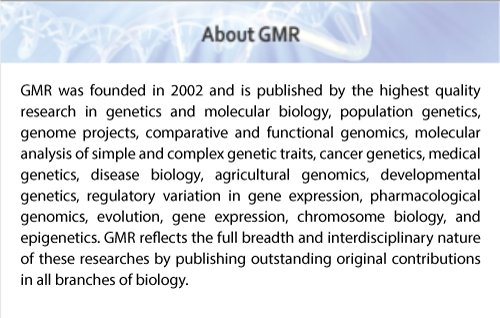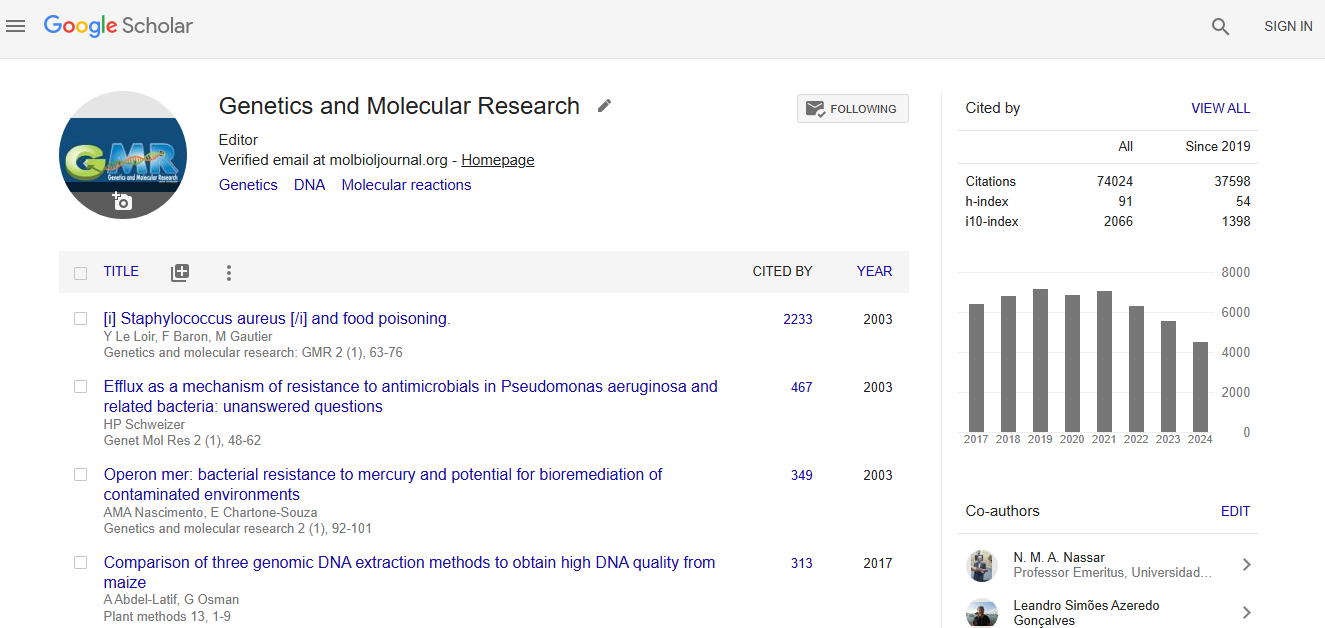
C.D. Cruz
Dynamism of the breeding program for irrigated rice in Southeast Brazil
The estimation of the genotypic replacement rate is aimed at evaluating the performance of breeding programs. Thus, the objective of this study was to evaluate the dynamics of the genetic improvement program of flooded rice, developed in Minas Gerais, during the period from 1993 to 2016. We evaluated 210 lines in three environments between 1993 and 2016, in blocks, ranging from three to four re.. Read More»
Genet. Mol. Res. 19(5):
Distinction between plant samples according to allele dosage by semiquantitative polymerase chain reaction
The lack of informativity of samples from heterozygotic individuals is one of the hindrances in the mapping of quantitative trait loci of outbred populations, since it is not normally possible to identify the origin of each allele. One way to include these individuals in analyses would be to genotype their endosperm, considering that a heterozygote (Aa) has AAa or A.. Read More»
Genet. Mol. Res. 8(1): vol8-1gmr585
DOI: 10.4238/vol8-1gmr585
Increasing genetic variability in black oats using gamma irradiation
The black oat (Avena strigosa Schreb) is commonly used for forage, soil cover, and green manure. Despite its importance, little improvement has been made to this species, leading to high levels of genotypic disuniformity within commercial cultivars. The objective of this study was to evaluate the efficiency of different doses of gamma rays [60Co] applied to black oat seeds on the increase of ge.. Read More»
Genet. Mol. Res. 13(4): 2014.December.4.28
DOI: 10.4238/2014.December.4.28
Potential of hypocotyl diameter in family selection aiming at plant architecture improvement of common bean
Cultivars of common bean with more erect plant architecture and greater tolerance to degree of lodging are required by producers. Thus, to evaluate the potential of hypocotyl diameter (HD) in family selection for plant architecture improvement of common bean, the HDs of 32 F2 plants were measured in 3 distinct populations, and the characteristics related to plant architecture were analyzed in t.. Read More»
Genet. Mol. Res. 14(3): http://dx.doi.org/2015.September.28.3
DOI: http://dx.doi.org/10.4238/2015.September.28.3
Regularized quantile regression applied to genome-enabled prediction of quantitative traits
Genomic selection (GS) is a variant of marker-assisted selection, in which genetic markers covering the whole genome predict individual genetic merits for breeding. GS increases the accuracy of breeding values (BV) prediction. Although a variety of statistical models have been proposed to estimate BV in GS, few methodologies have examined statistical challenges base.. Read More»
Genet. Mol. Res. 16(1): gmr16019538
DOI: 10.4238/gmr16019538
Artificial neural networks reveal efficiency in genetic value prediction
The objective of this study was to evaluate the efficiency of artificial neural networks (ANNs) for predicting genetic value in experiments carried out in randomized blocks. Sixteen scenarios were simulated with different values of heritability (10, 20, 30, and 40%), coefficient of variation (5 and 10%), and the number of genotypes per block (150 and 200 for validation, and 5000 for neural netw.. Read More»
Genet. Mol. Res. 14(2): 2015.June.18.22
DOI: 10.4238/2015.June.18.22
Evaluation of the efficiency of artificial neural networks for genetic value prediction
Artificial neural networks have shown great potential when applied to breeding programs. In this study, we propose the use of artificial neural networks as a viable alternative to conventional prediction methods. We conduct a thorough evaluation of the efficiency of these networks with respect to the prediction of breeding values. Therefore, we considered eight simulated scenarios, and for the .. Read More»
Genet. Mol. Res. 15(1): gmr.15017676
DOI: 10.4238/gmr.15017676
Artificial neural networks as auxiliary tools for the improvement of bean plant architecture
lassification using a scale of visual notes is a strategy used to select erect bean plants in order to improve bean plant architectures. Use of morphological traits associated with the phenotypic expression of bean architecture in classification procedures may enhance selection. The objective of this study was to evaluate the potential of artificial neural networks .. Read More»
Genet. Mol. Res. 16(2): gmr16029500
DOI: 10.4238/gmr16029500
Genetic gains from selection for fiber traits in Gossypium hirsutum L.
Brazil is among the five largest producers of cotton in the world, cultivating the species Gossypium hirsutum L. r. latifolium Hutch. The cultivars should have good fiber quality as well as yield. Genetic improvement of fiber traits requires the study of the genetic structure of the populations under improvement, leading to the identification of promising parent pla.. Read More»
Genet. Mol. Res. 15(4): gmr15048146
DOI: 10.4238/gmr15048146
Determination of the optimal number of markers and individuals in a training population necessary for maximum prediction accuracy in F2 populations by using genomic selection models
Genomic selection is a useful technique to assist breeders in selecting the best genotypes accurately. Phenotypic selection in the F2 generation presents with low accuracy as each genotype is represented by one individual; thus, genomic selection can increase selection accuracy at this stage of the breeding program. This study aimed to establish the optimal number o.. Read More»
Genet. Mol. Res. 15(4): gmr15048874
DOI: 10.4238/gmr15048874
Impact Factor an Index

Google scholar citation report
Citations : 74024
Genetics and Molecular Research received 74024 citations as per google scholar report
